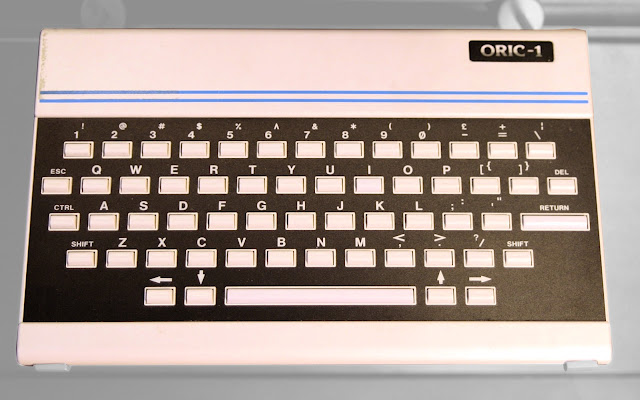Introduced January 1983
If you were in the market for a home computer in Britain in 1983, there would typically be three models that most people would choose: the Commodore 64, Sinclair ZX Spectrum or Acorn BBC Micro. There were other machines (such as the Dragon 32), and it did seem that this fast-growing market was ripe for more players.
One interested player was Tangerine Computer Systems, who had made the Microtan 65 some years earlier. Tangerine certainly had the technical skills to make a competitive machine, and seeing a gap in the market they set about creating the Oric-1 microcomputer, though a newly-formed subsidiary named Oric Products International.
 |
| Oric-1 |
The Oric-1 was very much aimed against the Spectrum end of the market, similarly priced and similar too in size. Based on a 6502 rather than a Z80, it was (like the Spectrum) available in 16Kb and 48Kb varieties – although a peculiarity of the hardware design meant that the latter actually had 64Kb of memory, the top 16Kb not be accessible without tinkering. The sound on the Oric was far better than on the Spectrum, using the popular AY-3-8910 chip. Four different graphics modes were available – more like the BBC than the Spectrum, and the inbuilt BASIC was pretty powerful as well. Last but not least, the chicklet keyboard had small, hard buttons which were much nicer to use than the Spectrum’s notorious “dead flesh” keyboard.
The main problem was bugs – the Oric-1’s ROM was full of them, and also the cassette interface was unreliable - which was a major problem for a home computer of the time. One other problem was that the promised peripherals – a printer interface, modem and floppy disk drive – ended up being later into production. Disappointments aside, it was a good system and sold at least a couple of hundred thousand units while it was on sale.
 |
| Oric-1 and Oric Atmos |
Oric struggled for money, but a takeover from a company called Edenspring Investments led to more money being available, leading to the improved Oric Atmos being launched in 1984. However, the home computer market was heading for a crash and Oric ended up in receivership – twice – before finally going bust in 1987. However, licensed cloned versions continued including the Bulgarian Pravetz 8D. A sad end, but of course today none of Acorn, Commodore or Sinclair are with us either so perhaps not unexpected.
Today the Oric-1 is an uncommon but collectable device, with prices for good systems being a couple of hundred pounds or so, the later Atmos commands higher prices and rarer derivatives more still. Perhaps in the end it wasn’t a significant machine, but there was
Image credits:
Rama via Wikimedia Commons - CC BY-SA 3.0 FR
Martin Wichary via Wikimedia Commons – CC BY 2.0

No comments:
Post a Comment